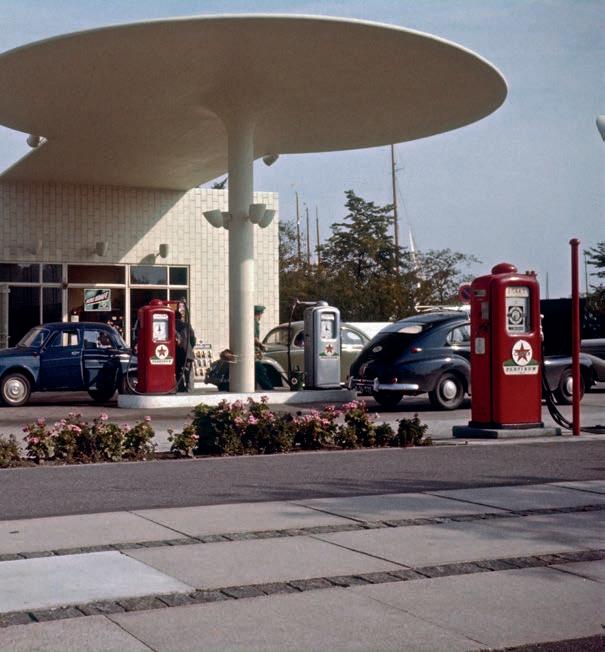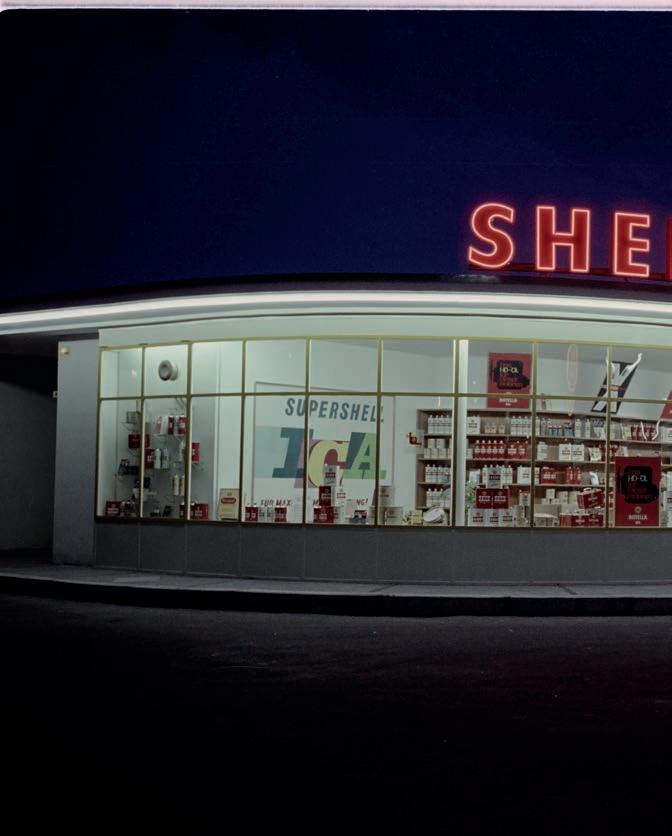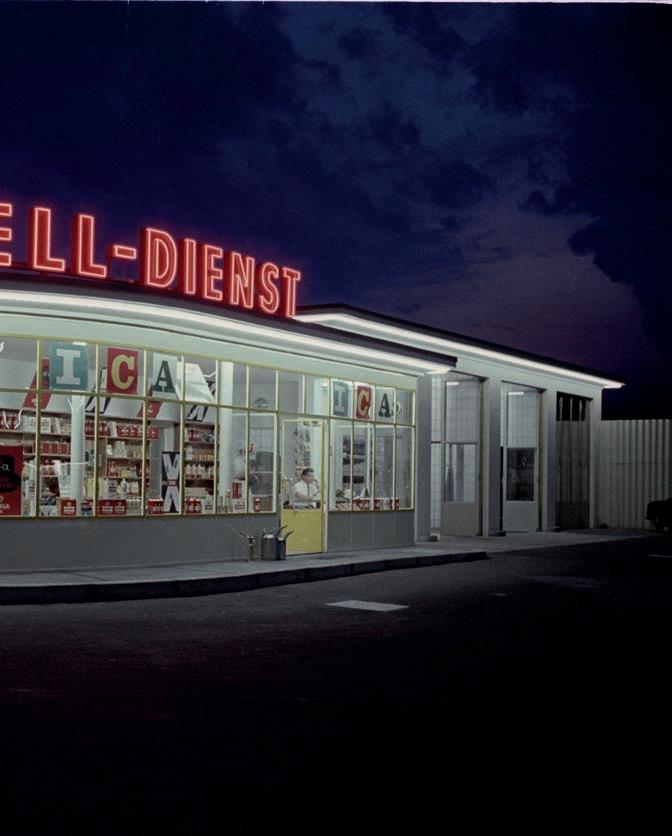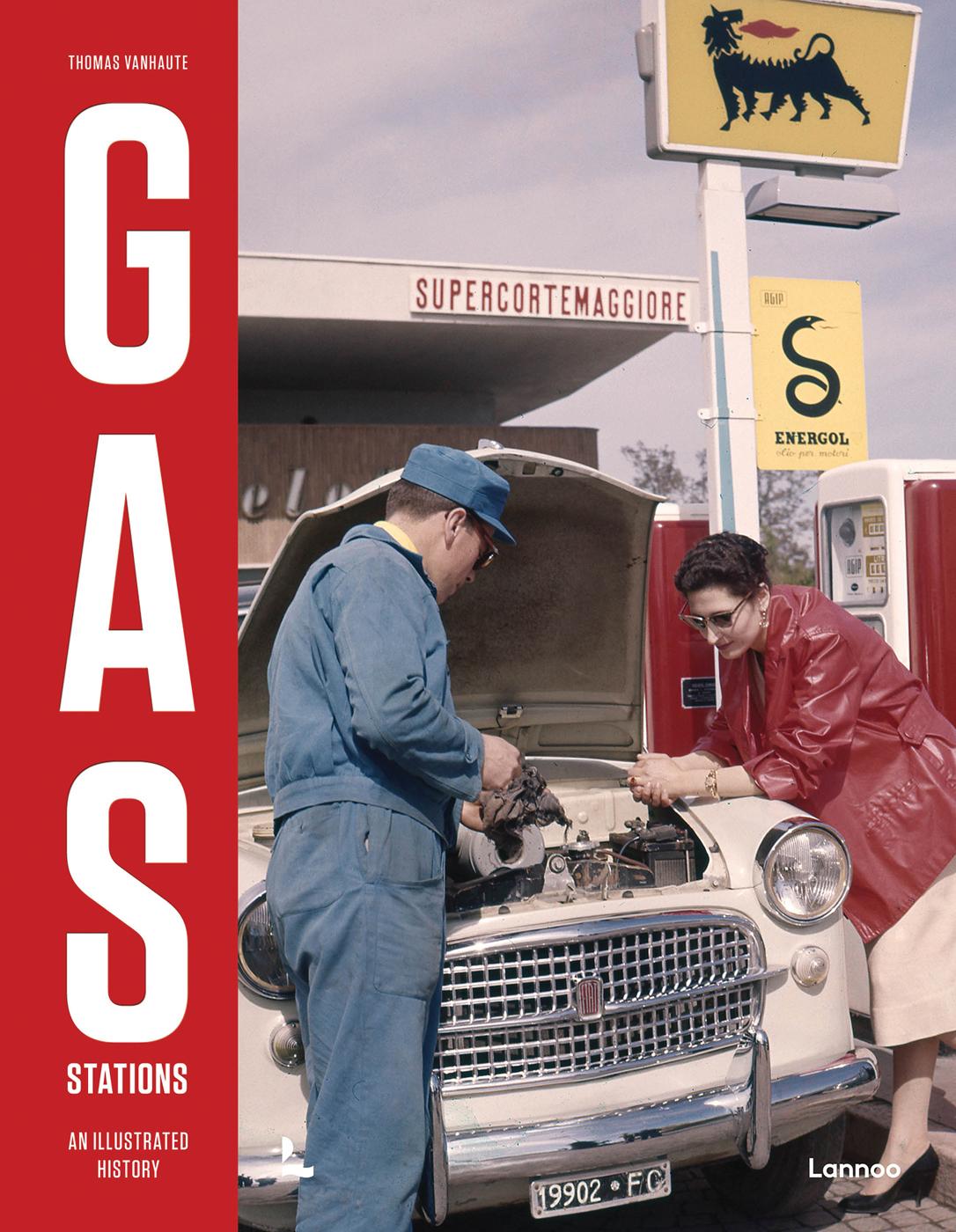
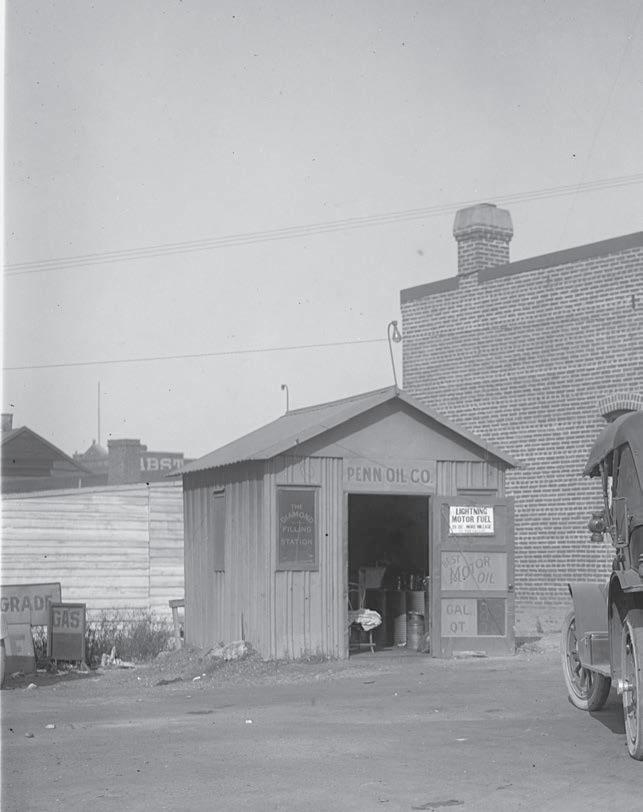
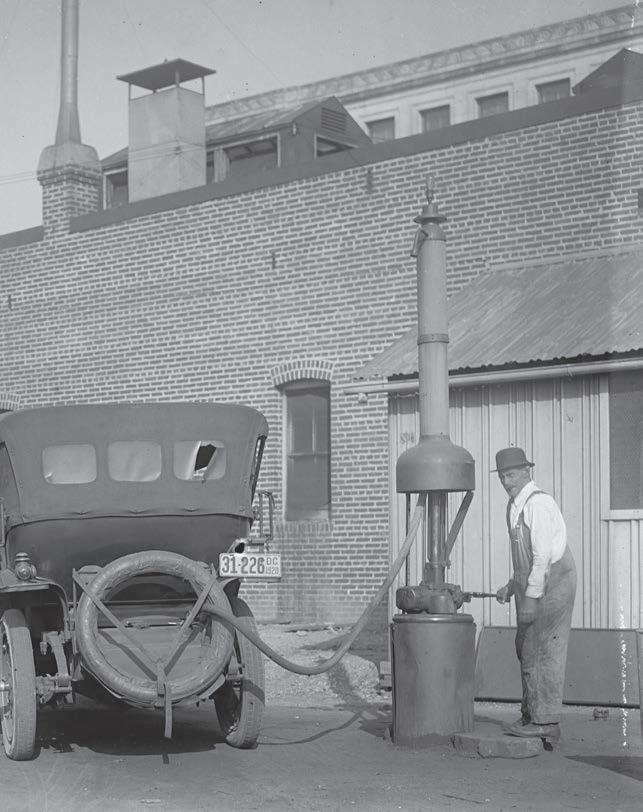
<
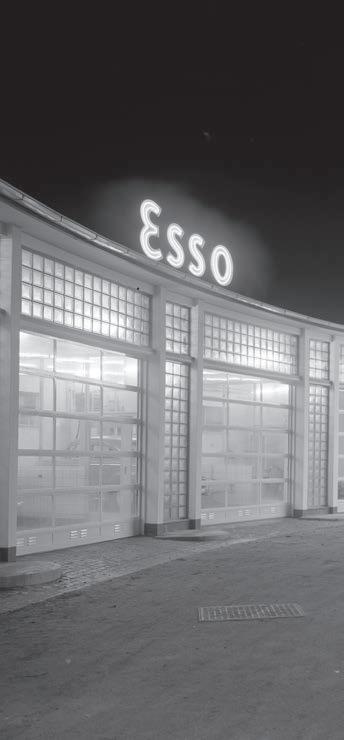
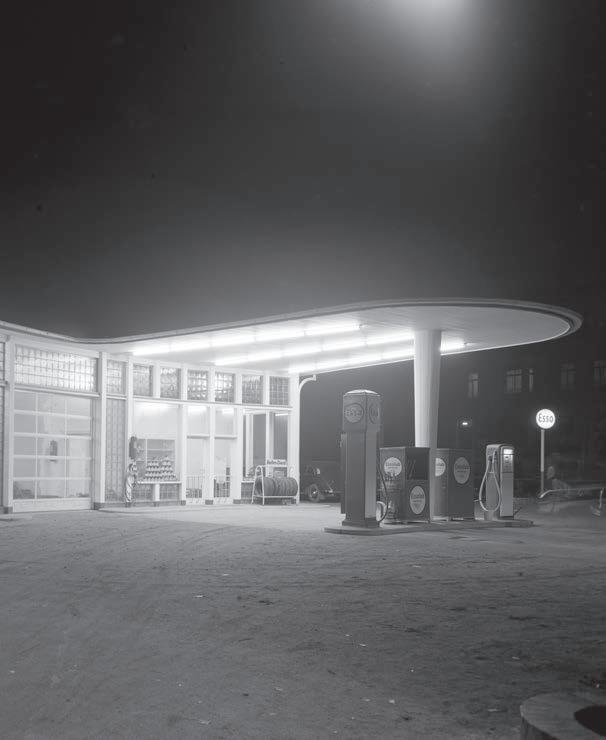
THE GAS STATION AS A MODERNIST STATEMENT
By the time car culture was widely adopted on both sides of the Atlantic in the 1930s, modernist architecture had already firmly established itself within building practice. Drawing from the functionalist design ideas of, among others, Walter Gropius’s Bauhaus and architects Robert Mallet-Stevens and Le Corbusier, gas station architecture from the late interwar and postwar period emphasized structure and program, reducing aesthetics to a by-product of the former. In doing so, modernist gas station architecture positioned itself as diametrically opposed to the ideas of the beautification-era architects, for whom lavish decoration was key. With its limited architectural program and status as a commercial nonplace, where customers would spend only a very limited amount of time, the gas station concept lent itself particularly well to artistic architectural expression. After all, besides dispensing the fuel, the key purpose of the building was to attract customers—so it had to stand out.
The gas station concept quickly became a favored typology among modernist architects. Here, they could experiment with forms and materials, without the limitations imposed by a demanding residential program. Of course, this was a logical extension of the love affair many influential modernist architects—including architecture icons like Frank Lloyd Wright and Le Corbusier—had with the automobile as a symbol of modernity and progress, as they based entire urban planning schemes around car use as prime mode of transportation. Modern architecture and the gas station typology were a match made in heaven, and its practical and almost industrial approach to building practice ensured both brand recognizability and ease of construction in large numbers, while keeping costs to a minimum. At the same time, the slender, clean lines of the modernist designs and their extensive use of glass, steel, and reinforced concrete projected purity (of product) and a positive, forward-looking brand identity.
In the USA, modernist architecture was very influential in gas station design. Inspired by the Bauhaus movement and the architectural theories of Le Corbusier of the mid-1920s, American industrial design pioneer Walter Dorwin Teague came up with a revolutionary concept in 1934 that would set the standard for gas station design for decades to come. Commissioned by Texaco to create a new look for its gas stations, Teague designed a streamlined, futuristic-looking modular building, using large glass facades and porcelain enamel panels for the exterior. This gas station concept was cheap to build in large numbers and easy to adapt to various added services (such as car maintenance and washing bays). The “oblong box,” or “icebox,” as the design would be aptly named, would be built by the thousands, across the USA and Europe, copied by several other oil companies during the 1940s and 1950s or used as a base template for their own designs. Teague’s design was nothing short of revolutionary and would be implemented worldwide. It is interesting to see how—despite largely following the concept of the oblong box—many gas station owners adapted Teague’s design to fit their own needs or preferences, adding structures and functions as they saw fit.
As many branded gas stations were privately owned, the owners were not always contractually obligated to follow a fixed station design and could add to the existing blueprint. If station owners did have to comply with the oil company’s architectural standards, a variety of possible predesigned solutions could be chosen from. Several large oil corporations would issue catalogs of standardized service stations models, each fit for a certain location and purpose. From small, single-space kiosk-like designs, to large, multiservice compounds, including washing and maintenance bays, a store, waiting rooms, and restrooms, besides, of course, the actual filling station area. Along major highways, some service stations would even comprise bars, coffeehouses, or even restaurants. These gas station concepts would eventually evolve into the highway rest stop in the early 1950s.
The gas station concept quickly became a favored typology among modernist architects. Here, they could experiment with forms and materials, without the limitations imposed by a demanding residential program.
> Germany, 1950s. Reinforced concrete and a so-called “mushroom-column” permitted the creation of large gas station canopies, without the need for multiple support columns (Alamy).
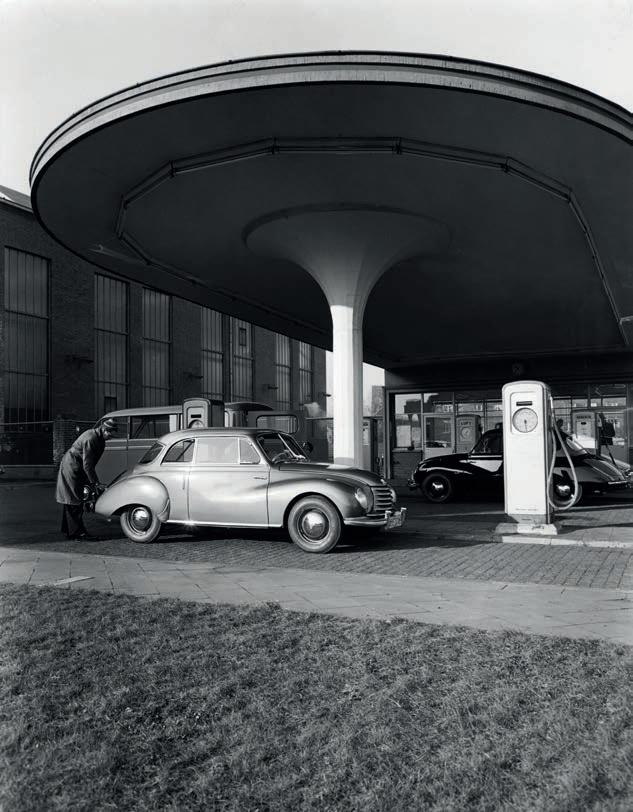
Despite the diversification in its commercial activities through the sale of tires, automotive batteries, and accessories, the modern rest stop would remain largely dependent on one sole commodity as its main source of income: gasoline. Like other major commodities, oil prices are primarily influenced by supply/demand, production cost, and market sentiment. But perhaps more than other commodities, oil production is regulated by a cartel of oilproducing nations and corporations. With demand for oil being continuously high and rising since the early 20th century, periodical crises in the supply-and-demand balance were to be expected. The first major crisis would appear right in the middle of the boom years of gas stations. When World War II broke out in Europe, gasoline was rationed and the military given priority to its use and supply. Gas rationing in the UK started in the very early days of the war, in 1939, and lasted until May 1950. UK customers were allowed only a certain amount of gasoline per vehicle, prices were fixed, and payment was made in the form of coupons. In Europe, gasoline sales grinded to a halt in the occupied countries. Once the USA entered the war, gasoline was also rationed in that country, too—from 1942 to 1945—reducing the total amount of gas consumed from highway use in the USA to thirty-two percent. Obviously, this had serious consequences for gas stations owners, certainly the independent ones. But with World War II over, the US economy would take off, and the amount of gas stations in the USA and Europe would continue to rise until well into the 1960s. The year 1956 saw another oil crisis, when the then Egyptian president Gamal Abdel Nasser nationalized the administration of the Suez Canal, a vital artery in the world’s oil supply chain. 1973 saw the most important of the oil crises following the OPEC oil embargo, resulting in gasoline rationing and a (voluntary) ban on gas sales on Saturday nights and Sundays in the USA. In Europe, many countries introduced rationing because of supply issues, while other countries such as France and the UK received almost uninterrupted oil supplies.
The successive oil crises, market saturation, increasing vehicle fuel efficiency, the arrival of self-service stations (the first one opening in Los Angeles as early as 1947), and increased infrastructure regulations meant the number of independently owned gas stations across the Western world declined rapidly in the last decades of the 20th century.
In gas station architecture, too, a crisis of sorts had settled in. As profit margins in the fuel retail business declined due to the factors mentioned above, gas stations operators—large and small—had to cut costs to keep afloat. As the optimism and faith in the future of the 1950s and 1960s gradually made way for a more sober outlook in Western society, so did the visual appeal and level of service of gas stations.
Attractive gas stations with an extended range of services were generally more expensive to maintain than simple structures providing only filling services, and so the colorful and appealing midcentury gas station architecture was gradually replaced by the most basic and cost-effective form available: a forecourt with a few self-service gas pumps, covered by a steel-framed canopy. In a way, the archetype of the gas station had resurfaced. Although regional differences occurred, a decline in full-service gas stations in favor of stations supplying filling services only became apparent from the late 1960s onward. With self-service stations gradually becoming the norm both in the USA and Europe, the days of helpful gas station attendants making sure your windscreen got wiped and your tire pressure was checked were all but gone. When stricter environmental regulations were imposed on gas stations in the 1990s, many independent gas station owners could or would not bring themselves to invest in expensive new storage systems and pumps, and many would call it quits. Only the very large multinational oil corporations remained, reducing a once colorful and multifaceted gas stations landscape to a dull, uniform chain of fuel outlets, with identical shapes and forms, from Sidney to Anchorage.
As the optimism and faith in the future of the 1950s and 1960s gradually made way for a more sober outlook in Western society, so did the visual appeal and level of service of gas stations.

Bremen (Germany), 1937. The station attendant pumps gasoline from a Standard dispenser, while his young assistant fills up the tank of an Auto-Union automobile (Staatsarchiv Bremen).
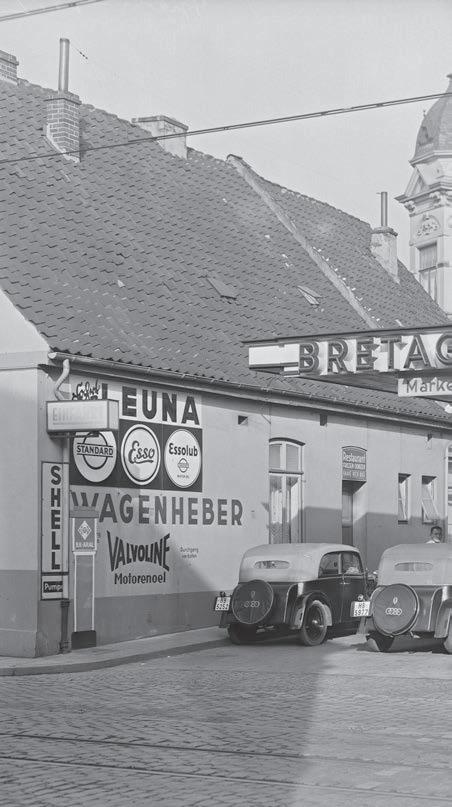
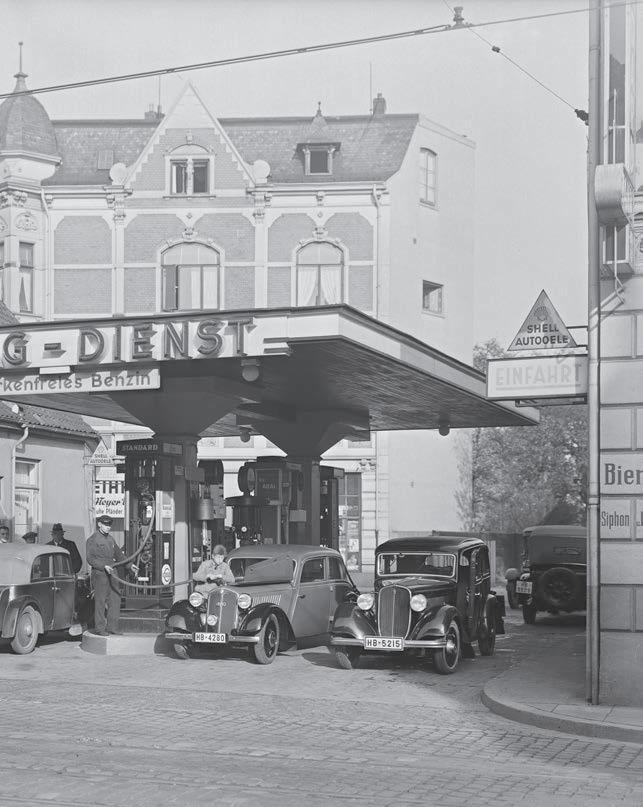
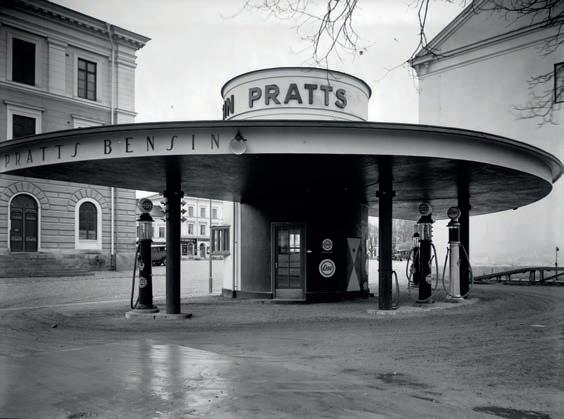

Standard gas station, Gävle (Sweden), 1939 (Länsmuseet Gävleborg).
> Signal service station, Los Angeles, California, 1933. Cashing in on the popular 1932 Tarzan the Ape Man Hollywood movie, the Signal Oil & Gas Co. established a “Tarzan Club,” aimed at the children of potential customers. Special prizes, including a leopard-print children’s bathing suit, could be won. Such a leopard bathing suit can be seen in this photograph, on display on the central fuel pump.
Danish architect and product designer Arne Jacobsen (1902-1972) is perhaps best known for his furniture and tableware designs, but his architectural works are prime examples of the scandinavian modern movement of the interwar years. In 1937, Jacobsen was commissioned by Texaco to build a gas station near the Skovshoved harbour area north of Copenhagen (Denmark). The elegant, functionalist design of the building is a clear reference to the modernist architectural ideas of the German Bauhaus school and Swiss architect Le Corbusier.
The station is still in use today (see page 196) (Photograph by Arne Jacobsen. Copyrights Arne Jacobsen Design I/S).

